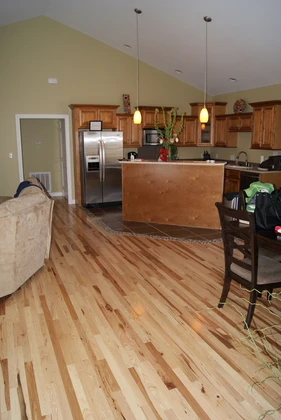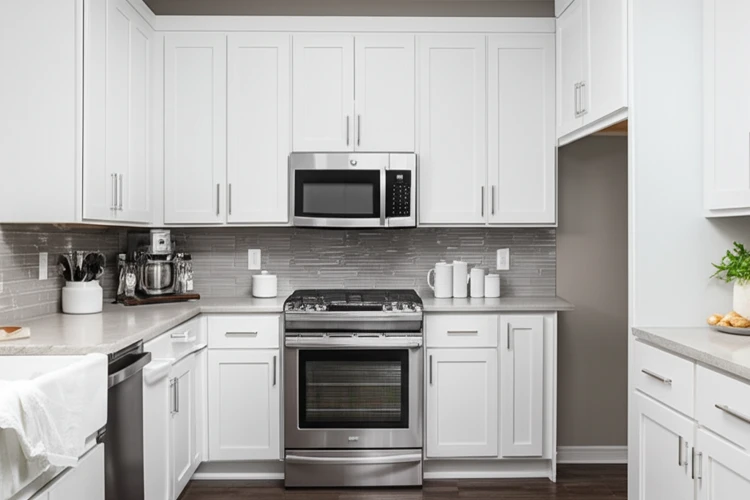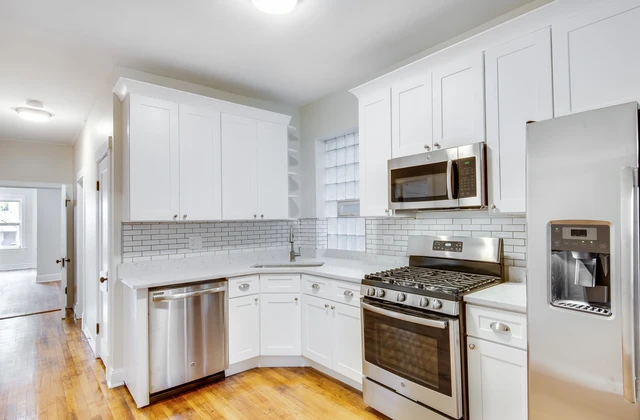Disclaimer: As an Amazon Associate, I earn commission from qualifying purchases.
Wood floors have long been a staple in kitchen design, offering both aesthetic appeal and practical benefits. For homeowners, renters, and kitchen enthusiasts alike, choosing the right wood floor can significantly enhance the overall functionality and beauty of the kitchen space. With over a decade of experience in home improvement and interior design, this article aims to provide a comprehensive guide to optimizing kitchen efficiency with wood floors.
By referencing reputable sources like “Flooring Magazine” and industry experts, we ensure that our recommendations are grounded in authoritative knowledge while encouraging readers to consult professionals for personalized advice.
Benefits of Wood Floors in the Kitchen
Wood floors offer a multitude of advantages that make them an excellent choice for kitchens. Firstly, their durability is unmatched. High-quality wood floors can last for decades with proper care. According to industry statistics, well-maintained wood floors can have a lifespan of over 100 years. This longevity is a significant selling point for homeowners looking for a long-term investment.
Ease of cleaning is another major benefit. Wood floors can be swept, vacuumed, and mopped with minimal effort, making them ideal for busy kitchens. Regular cleaning helps maintain the floor’s appearance and extends its lifespan. However, it’s important to note that wood floors can be susceptible to moisture, which is a common concern in kitchens. Promptly addressing spills and using area rugs in high-moisture areas can mitigate this risk.
Aesthetically, wood floors add a warm, natural touch to any kitchen. They come in a variety of colors, grains, and finishes, allowing homeowners to customize their kitchen’s look to fit their personal style. Whether you prefer a rustic, traditional, or modern aesthetic, there’s a wood floor option that will complement your design vision.
Types of Wood Floors Suitable for Kitchens
When considering wood floors for your kitchen, it’s essential to understand the different types available. Each type has its unique features and benefits:
Hardwood Floors
Hardwood floors are renowned for their durability and classic appeal. Made from solid wood, they offer excellent longevity and can be sanded and refinished multiple times. However, they are more susceptible to moisture and humidity changes, which can cause warping and cupping.
Engineered Wood Floors
Engineered wood floors consist of a thin layer of real wood on top of a plywood base. This construction makes them more stable and resistant to moisture compared to solid hardwood. They are a popular choice for kitchens due to their durability and ease of installation.
Laminate Floors
Laminate floors mimic the appearance of wood but are made from composite materials. They are highly resistant to scratches, stains, and moisture, making them a practical option for high-traffic kitchens. However, they cannot be refinished like solid hardwood.
When choosing a type of wood floor, it’s crucial to consider pricing. Hardwood floors tend to be the most expensive, while laminate floors are generally the most cost-effective. Engineered wood floors fall somewhere in between, offering a balance of quality and affordability.
Choosing the Right Wood Floor for Your Kitchen
Selecting the right wood floor for your kitchen involves considering several factors, including lifestyle, budget, and design preferences. Here’s a step-by-step guide to help you make an informed decision:
Step 1: Assess Your Lifestyle
Consider the level of foot traffic and the presence of pets or children. Hardwood and engineered wood floors are suitable for high-traffic areas, while laminate floors offer excellent scratch resistance.
Step 2: Determine Your Budget
Establish a budget range for your flooring project. Keep in mind that while hardwood floors may have a higher upfront cost, their longevity can make them a cost-effective long-term investment.
Step 3: Consider Your Kitchen Design
Choose a wood floor that complements your kitchen’s overall aesthetic. Darker woods can add a touch of elegance, while lighter woods create a bright, airy feel. Consider the color and style of your cabinets, countertops, and appliances to ensure a cohesive look.
A helpful checklist for evaluating your needs includes assessing the durability requirements, budget constraints, and design preferences. Consulting professional design and flooring journals can provide additional insights and case studies to guide your decision.
Installation Tips for Wood Floors in the Kitchen
Installing wood floors in the kitchen requires careful planning and the right tools. Here are some practical tips to ensure a successful installation:
Preparation
Ensure the subfloor is clean, dry, and level. Any imperfections in the subfloor can affect the final appearance and stability of the wood floor. Use a leveling compound if necessary.
Tools and Techniques
Gather the necessary tools, including a saw, mallet, spacers, and a flooring nailer or stapler. Follow the manufacturer’s guidelines for installation techniques, such as staggering seams and ensuring proper expansion gaps.
Professional Help
While DIY installation is possible, it’s advisable to consult a professional for complex installations. Professional help ensures a high-quality finish and can address any unforeseen issues during the installation process.
Maintaining Wood Floors in the Kitchen
Proper maintenance is key to preserving the beauty and longevity of wood floors in the kitchen. Here are some guidelines to keep your wood floors in top condition:
Cleaning Methods
Regularly sweep or vacuum the floor to remove dirt and debris. Use a damp mop with a mild cleaning solution specifically designed for wood floors. Avoid using excessive water, as it can damage the wood.
Preventive Measures
Place area rugs in high-traffic areas and near sinks to protect the floor from moisture and scratches. Promptly address spills to prevent water damage. Regularly check for signs of wear and address any issues promptly.
Addressing Common Issues with Wood Floors in the Kitchen
Despite their many benefits, wood floors can face challenges in the kitchen environment. Here are some common issues and their solutions:
Moisture
Moisture is the biggest enemy of wood floors. To prevent moisture damage, ensure proper ventilation and promptly address any leaks or spills. Use area rugs in high-moisture areas and consider installing a moisture barrier during installation.
Scratches
Scratches can be minimized by placing furniture pads under heavy items and using area rugs in high-traffic areas. Regular cleaning and the use of protective finishes can also help maintain the floor’s appearance.
Stains
Stains can be addressed by promptly cleaning spills and using appropriate cleaning products. For tough stains, consult a professional for specialized treatment.
Sustainability and Wood Floors in the Kitchen
For environmentally conscious homeowners, sustainability is a crucial consideration when choosing wood floors. Here are some eco-friendly options and certifications to look for:
Eco-Friendly Options
Bamboo and reclaimed wood are popular sustainable options. Bamboo is a rapidly renewable resource, while reclaimed wood repurposes existing materials, reducing waste. Both options offer durability and aesthetic appeal.
Certifications
Look for wood floors certified by the Forest Stewardship Council (FSC) or other recognized environmental certifications. These certifications ensure that the wood is sourced responsibly and sustainably.
Enhancing Kitchen Efficiency with Wood Floors
Wood floors can contribute to overall kitchen efficiency in several ways:
Ease of Movement
The smooth, even surface of wood floors facilitates easy movement, making tasks like cooking and cleaning more efficient. The lack of grout lines or uneven surfaces reduces tripping hazards and improves mobility.
Ease of Cleaning
Wood floors are easy to clean, requiring minimal effort to maintain their appearance. Regular sweeping and mopping keep the floor in top condition, reducing the time and effort needed for cleaning.
Product Recommendations for Wood Floors in the Kitchen
When selecting wood floors for your kitchen, consider these recommended products:
Bruce Hardwood Floors
Bruce offers a wide range of high-quality hardwood floors known for their durability and aesthetic appeal. Their products are available in various finishes and species, catering to different design preferences.
Shaw Engineered Wood Floors
Shaw’s engineered wood floors are renowned for their stability and resistance to moisture. They offer a variety of styles and finishes, making them a versatile choice for kitchens.
Pergo Laminate Floors
Pergo laminate floors are highly resistant to scratches, stains, and moisture, making them an excellent option for high-traffic kitchens. They offer a wide range of designs that mimic the look of real wood.
Design Ideas for Wood Floors in the Kitchen
Integrating wood floors into your kitchen design can be both functional and aesthetically pleasing. Here are some design ideas to inspire you:
Rustic Charm
For a rustic look, opt for wide-plank hardwood floors with a distressed finish. Pair them with natural wood cabinets and warm, earthy tones to create a cozy, inviting atmosphere.
Modern Elegance
Achieve a modern aesthetic with sleek, engineered wood floors in a light or medium tone. Combine them with contemporary cabinets and stainless-steel appliances for a clean, sophisticated look.
Coastal Vibe
Create a coastal-inspired kitchen with light-colored wood floors and a matte finish. Pair them with white or light blue cabinets and nautical-themed decor for a breezy, beachy feel.
FAQs
What is the best type of wood floor for a high-traffic kitchen?
Engineered wood floors are often recommended for high-traffic kitchens due to their durability and resistance to moisture. They offer the look of real wood with added stability, making them a practical choice for busy kitchens.
How often should wood floors in the kitchen be refinished?
The frequency of refinishing depends on the type of wood and the level of wear, but generally, every 10-15 years is a good guideline. Regular maintenance and promptly addressing issues can extend the time between refinishing.
Can wood floors be installed over existing kitchen tiles?
Yes, wood floors can be installed over existing tiles, but it requires proper preparation and leveling of the surface. Ensure the tiles are securely adhered and the surface is clean and dry before installation.
What are some eco-friendly options for wood floors in the kitchen?
Bamboo and reclaimed wood are eco-friendly options that are both durable and sustainable. Bamboo is a rapidly renewable resource, while reclaimed wood repurposes existing materials, reducing waste.
How can I prevent moisture damage to wood floors in the kitchen?
Regular cleaning, promptly addressing spills, and using area rugs in high-moisture areas can help prevent moisture damage. Ensure proper ventilation and consider installing a moisture barrier during installation.
Can I install wood floors in a kitchen with radiant heating?
Yes, wood floors can be installed over radiant heating systems, but it’s crucial to choose the right type of wood and follow the manufacturer’s guidelines. Engineered wood floors are often recommended for their stability and resistance to temperature changes.
Conclusion
Wood floors offer a blend of aesthetic appeal and practical benefits that make them an excellent choice for kitchens. By understanding the different types of wood floors, selecting the right one for your lifestyle and budget, and following proper installation and maintenance practices, you can enhance the efficiency and beauty of your kitchen.
Remember to consult professionals for personalized advice and to ensure a high-quality finish. Embrace the warmth and durability of wood floors to create a kitchen that is both functional and visually stunning.







